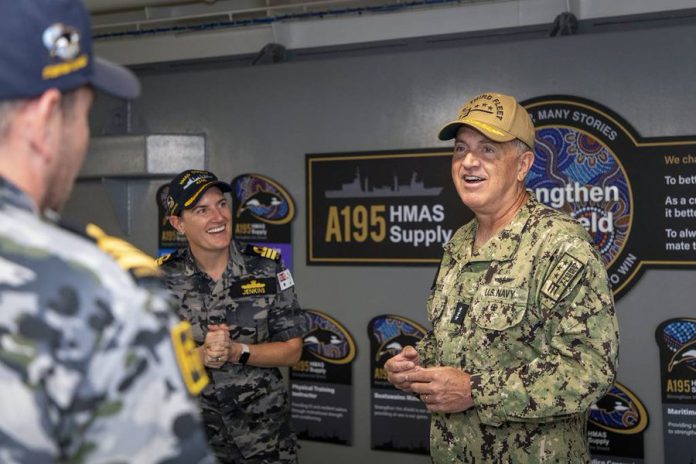The U.S is closer to conflict in the Pacific than it is to peace, the head of U.S 3rd Fleet said, and the command structure must change to reflect that.
Vice Admiral Michael Boyle has called for a centralised command-and-control structure — a standing maritime force similar to those elsewhere around the globe — that could rapidly respond to a crisis in the Indo-Pacific region.
Speaking to Defence News at the Rim of the Pacific exercise, which runs 29 June -04 August, Boyle said the training event helps tighten the coalition of partners in the region and align their tactics.
But he noted more must be done to adjust to this new posture, including understanding when each country’s military is authorised to join an operation by the proposed maritime force; which nations would join a humanitarian assistance or disaster relief mission; and which nations would join in a fight against China or North Korea.
“We historically in this [area of responsibility] have thought about war as an esoteric adventure out somewhere in the future, not something that’s happening every day,” Boyle added. But a conflict could reasonably arise, “and we have to be ready to go.”
That means having the joint force — including space and cyber assets — as well as partners and allies aligned so that, at the first sign of an adversary preparing an attack, the coalition could quickly intervene and pose dilemmas to the enemy.
Boyle believes China will continue its gray zone activities but won’t escalate to full conflict until it’s confident it can win. A standing command structure would “look at what China, Russia and North Korea do, and then we posture the force to induce dilemmas into their thinking. We ultimately want them to think: ‘Today is not the day to go against this joint, combined force.”
Boyle pointed to a couple other standing groups as inspiration for the proposed Pacific force. In the Middle East, the Combined Maritime Forces naval partnership has 34 members that support three task groups, who in turn cover 3.2 million square miles of international waters. The group is led by the U.S. Navy three-star admiral who leads U.S 5th Fleet and U.S Naval Forces Central Command, and the deputy is a British Royal Navy commodore.
In the Pacific, Boyle pointed to the Pacific Security Maritime Exchange, a nine-nation information-sharing group dedicated to stopping North Korea from violating United Nations sanctions. He also cited the Indo-Pacific Maritime Coordination Centre, one of three fusion centers in which that U.S Indo-Pacific Command has invested in order to share data for identifying at-sea threats.
“We have pockets of excellence; I think we need a larger, centralised clearinghouse where you can plug into,” he said.
Boyle took command of 3rd Fleet in mid-June after serving as the director of maritime operations at U.S Pacific Fleet. His past assignments include commanding an air wing based in Japan, leading a carrier strike group that deployed to the Pacific, commanding naval forces in South Korea, and serving as the executive assistant to two previous Pacific Fleet commanders.
Given his extensive experience in the Pacific, Boyle acknowledged he has his sights set a bit beyond the typical purview of a 3rd Fleet commander, which includes preparing ready forces to deploy and coordinating defense support to civil activities.
If a conflict broke out, “as 3rd Fleet, I’m no different than 7th Fleet: I’ll be forward as a maneuver element of the fight.”
While 3rd Fleet operates along the American West Coast and around Hawaii, 7th Fleet is located on the other side of the international dateline. Where 3rd Fleet can differentiate himself from 7th Fleet is the former’s ability to pull in partners from Central and South America, several of whom are participating in RIMPAC right now, he said.
Boyle said he can’t dispatch U.S Navy ships to those regions, which fall under U.S 4th Fleet, for local exercises, such as UNITAS. But he can help couch them in the context of a Pacific fight and advocate for U.S participation, and he hopes that setting up a formal command-and-control structure in the Pacific could serve to tighten the relationship with countries like Chile, Mexico and Peru, who have ships and ground forces at RIMPAC this year.
As 3rd Fleet commander, Boyle also leads the RIMPAC exercise and the entire combined task force during the event. He wants this year’s annual drill to “force commanders to think a little bit more.” They may not know what exactly the threat is and how the exercise scenario will unfold, but he wants them to have a solid understanding of what capabilities exist within partner nations and who is authorised to participate as the conflict scales up; this way, he explained, they can begin to think through various options as scenarios progress.
“That’s not the goal of RIMPAC overall, but I’m trying to set the foundation so that, as we move forward, future RIMPACs are an opportunity to rehearse centralized command and control of a combined force,” he said.
“I can’t help but continue the work that I started in my previous job,” he added. “This is not just ships driving together — it’s understanding the command-and-control structure they’re going to have plug into,” said Boyle.
SOURCE: DEFENCE NEWS/PACNEWS














